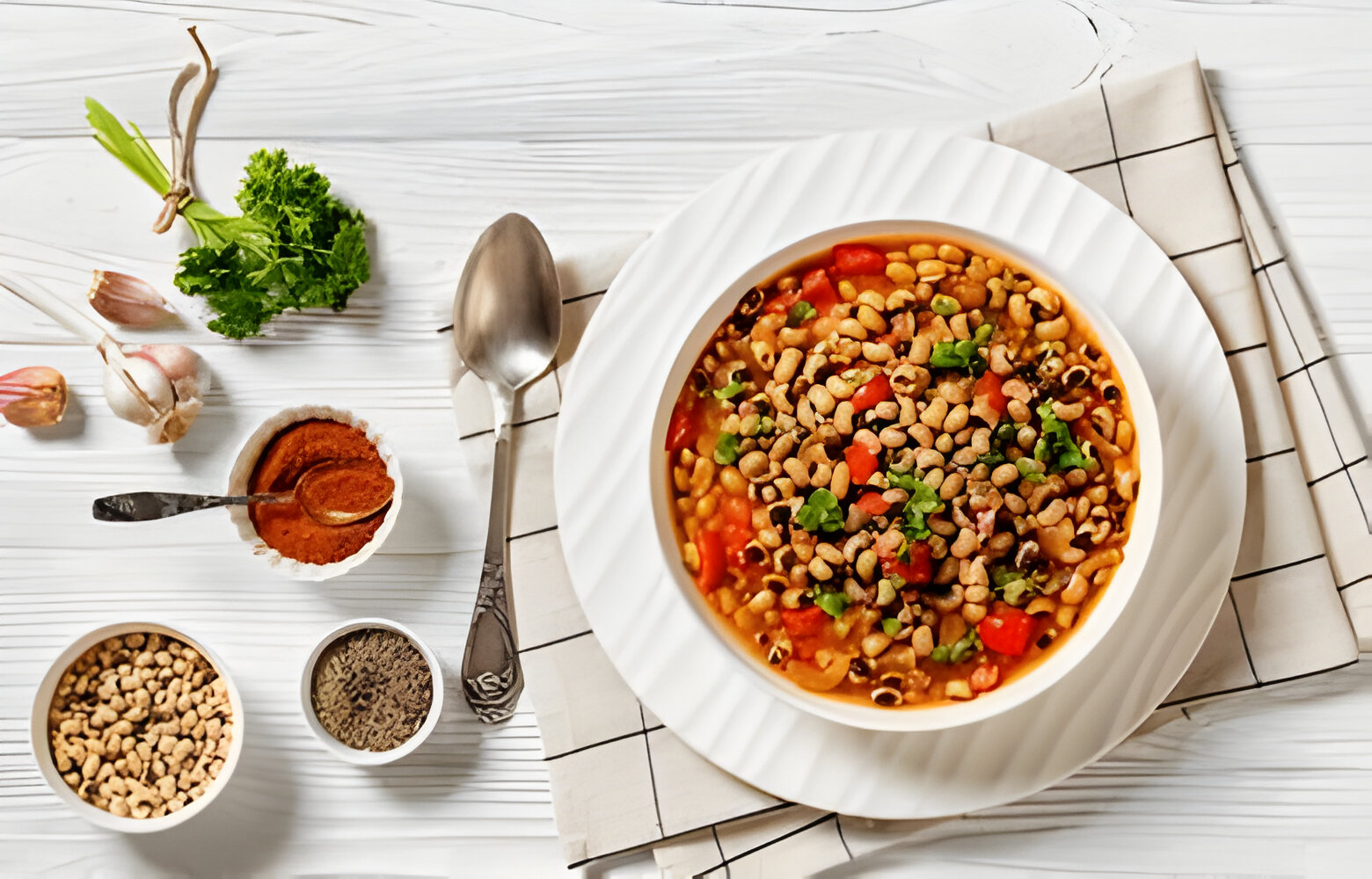Introduction: Celebrating with Black Eyed Peas
Black eyed peas recipe are not just a tasty legume; they hold a cultural significance particularly strong in the Southern United States. Consumed traditionally on New Year’s Day, they are believed to bring good luck and prosperity throughout the year. This humble pea, with its distinctive black spot, has been a staple in diets for centuries, linked closely to celebrations and family gatherings.
The Origins and Traditions
- Black eyed peas recipe were introduced to the American South via African cuisine and quickly became integral to regional culinary traditions.
- Their preparation varies, but often includes pork for seasoning and greens that represent economic fortune.
- For a detailed look at a traditional recipe, you might explore Allrecipes’ New Year’s Day Black-Eyed Peas, which provides a classic version of this dish.
Culinary Significance
- Beyond symbolism, black eyed peas are valued for their nutritional benefits. They are rich in protein, fiber, and iron.
- They can be prepared in various ways, from simple stews to complex dishes that highlight the pea’s versatility and mild flavor.
- Incorporating black eyed peas into meals is not only a nod to tradition but also a health-conscious choice for modern diets.
The role of black eyed peas extends beyond just a food item; they are a symbol of hope and renewal. As such, they occupy a special place in culinary and cultural history, making them a fascinating subject for both cooking and discussion. Whether you’re aiming to start a new tradition or simply looking for a nutritious meal, black eyed peas offer a wealth of possibilities.
Traditional Black Eyed Peas Recipe
Preparing a traditional black eyed peas dish can vary slightly depending on regional preferences, but the core ingredients and method remain consistent. This classic recipe serves as a foundation for newcomers and a reminder for seasoned cooks of the simple pleasures of this humble legume.
Ingredients and Preparation
- Begin with 1 pound of dried black eyed peas. Soaking them overnight can decrease cooking time and improve digestibility.
- Sauté a medium chopped onion and two cloves of garlic until translucent, adding a rich base flavor to the dish.
- For a deeper dive into ingredient variations and cooking techniques, the Best Ever Black-Eyed Peas Recipe from Food.com is an excellent resource.
Cooking Steps
- Drain the soaked peas and add them to a large pot with about 6 cups of water or broth for enhanced flavor.
- Introduce smoked ham, bacon, or even turkey for a smoky depth, adjusting according to dietary preferences.
- Simmer the mixture gently for about 1 to 2 hours until the peas are tender, stirring occasionally to prevent sticking.
This straightforward approach to cooking black eyed peas not only preserves the traditional essence of the dish but also allows for personal touches. Whether you’re cooking for a holiday meal or looking for a nutritious everyday option, this recipe offers flexibility and flavor. By following these steps, you can ensure your black eyed peas are both delicious and a nod to culinary tradition. As you gain confidence, feel free to experiment with spices and ingredients to personalize your dish even further.
Enhancing Flavor and Texture in Black Eyed Peas
Exploring advanced cooking techniques can transform your black eyed peas from a simple dish to a standout meal. These methods focus on maximizing flavor and achieving the perfect texture.
Soaking and Seasoning
- Soaking black eyed peas overnight not only shortens cooking time but also improves their texture and aids in digestion. A thorough rinse before cooking is essential to remove any impurities and excess starch.
- Incorporating aromatics such as bay leaves, thyme, or smoked paprika during the cooking process can infuse the peas with deep, complex flavors.
Slow Cooking Perfection
- Using a slow cooker can yield exceptionally tender peas with minimal effort. This method allows for better absorption of flavors and ensures that the peas cook evenly.
- Adding a smoked ham hock or bacon during the slow cooking process imparts a rich, savory depth that complements the natural mildness of the black eyed peas.
Pressure Cooking for Efficiency
- For those short on time, pressure cooking black eyed peas can drastically reduce cooking time without sacrificing taste or texture.
- Ensure natural release of pressure to avoid mushiness, giving the peas ample time to settle and absorb the surrounding flavors fully.
These advanced techniques provide several options to elevate your black eyed peas dish. Whether you prefer the slow melding of flavors in a crockpot or the speedy efficiency of a pressure cooker, each method offers unique benefits. Experimenting with these techniques will help you discover your favorite way to prepare this versatile and nutritious legume.
Storing and Reheating Black Eyed Peas
Properly maintaining the quality of leftover black eyed peas ensures that they remain just as enjoyable the next day. Here are essential tips for storing and reheating this dish to keep it tasting fresh.
Effective Storage Solutions
- Cool the black eyed peas to room temperature before storing to prevent bacterial growth.
- Use airtight containers for refrigeration to maintain freshness and avoid absorbing odors from other foods. Properly stored, black eyed peas can last up to four days in the refrigerator.
Reheating Techniques
- When ready to reheat, choose a method that will best preserve the texture and flavor. Gently reheating on the stovetop with a splash of water or broth can prevent the peas from drying out.
- Avoid using high heat in the microwave as it can unevenly reheat and alter the texture of the black eyed peas. Instead, opt for a medium setting and stir occasionally to ensure even warmth throughout.
Freezing for Longevity
- For long-term storage, freezing black eyed peas is an excellent option. Ensure they are completely cooled and store in freezer-safe bags or containers.
- To use frozen peas, thaw in the refrigerator overnight and then reheat as needed, allowing you to enjoy the dish without compromise on taste or texture.
By following these storage and reheating guidelines, you can extend the life of your black eyed peas while maintaining their quality. This approach not only reduces food waste but also provides a quick and easy meal option for busy days.
Adapting Black Eyed Peas for Different Diets
Creating dietary-specific versions of black eyed peas recipes allows everyone to enjoy this nutritious dish, regardless of their dietary restrictions. Here’s how to adapt the classic recipe to meet vegan, gluten-free, and low-sodium requirements.
Comfort Food Classics: Integrate a link to Fried Cabbage Recipes which explores another Southern comfort food that pairs well with black eyed peas.
Vegan Variations
- Substitute any meat or animal-based ingredients with plant-based alternatives like smoked tofu or tempeh to maintain the smoky flavor without the meat.
- Use vegetable broth instead of chicken or beef broth to cook the black eyed peas, enriching the dish with a layer of vegetable-based flavors.
Gluten-Free Adjustments
- Ensure that all added ingredients, such as broths or seasonings, are certified gluten-free. This precaution helps prevent cross-contamination and keeps the dish safe for those with gluten sensitivities.
- Consider natural thickening agents like cornstarch or arrowroot powder in place of flour if the recipe requires thickening.
Low-Sodium Solutions
- Reduce sodium by rinsing canned black eyed peas thoroughly if not using dried peas. This simple step can remove up to 40% of the added sodium.
- Prepare the dish with low-sodium or no-salt-added broths and avoid adding extra salt during cooking. Enhance flavor with herbs and spices like bay leaves, garlic, and cumin instead.
These adaptations ensure that black eyed peas can be a versatile and inclusive dish, suitable for a variety of dietary needs. By making small adjustments, this nutritious legume can remain a staple in any kitchen, bringing its rich flavors and health benefits to all tables.
Hearty Family Meals: Connect to the Ground Beef Potato Casserole to suggest a perfect side dish that complements black eyed peas for a family dinner.
Frequently Asked Questions About Cooking Black Eyed Peas
Addressing common queries can help improve your experience when cooking black eyed peas. Here are answers to some of the most frequently asked questions that can enhance your culinary results.
How Long Should Black Eyed Peas Be Cooked?
- The cooking time for black eyed peas varies depending on whether they are fresh, dried, or canned. Dried peas, which are the most common, typically require about 1 to 2 hours of cooking after being soaked overnight. If you’re using a pressure cooker, this time can be reduced significantly.
Dried vs. Canned Black Eyed Peas: Which is Better?
- Choosing between dried and canned black eyed peas depends on your time constraints and flavor preferences. Dried peas offer a fresher taste and less sodium but require more preparation time. Canned peas are convenient and save time, but it’s important to rinse them thoroughly to reduce sodium content.
Can I Enhance the Flavor of Black Eyed Peas?
- Absolutely! Enhancing the flavor of your black eyed peas can be done through the addition of spices such as cumin, coriander, and smoked paprika. Incorporating aromatic vegetables like onions, garlic, and bell peppers during the cooking process can also add depth to the dish.
These FAQs aim to simplify the process of cooking black eyed peas, ensuring that your dishes are both delicious and successful. With these tips, you can tailor your approach to suit your taste preferences and dietary needs, making black eyed peas a versatile component of your culinary repertoire.
Healthy Eating: Link to the Easy Roasted Frozen Broccoli Recipe for those looking to pair a healthy, quick side dish with their black eyed peas meal.
Bringing Tradition to Your Table
Embracing the rich history and health benefits of black eyed peas can enrich your dining experience and introduce time-honored traditions into your modern meals. This conclusion highlights the significance of incorporating this versatile legume into your diet.
Cultural and Nutritional Value
- Black eyed peas are more than just a staple ingredient; they are a symbol of luck and prosperity in many cultures, especially when eaten at the start of the New Year.
- Nutritionally, they are packed with protein, fiber, and essential nutrients, making them an excellent addition to any diet.
Encouraging Culinary Exploration
- The versatility of black eyed peas allows for a myriad of culinary experiments. From simple, comforting stews to elaborate dishes infused with international flavors, there’s no limit to how they can be used.
- We encourage you to explore beyond the traditional recipes and experiment with spices, cooking methods, and combinations that might not be as familiar.
Conclusion
- As we reflect on the role of black eyed peas in culinary traditions, let their rich history inspire your cooking. Whether you’re preparing a meal for a festive occasion or simply looking for a nutritious addition to your diet, black eyed peas offer a delicious and healthful choice.
By integrating black eyed peas into your cooking repertoire, you embrace a tradition that spans cultures and centuries. This humble legume is not only a cornerstone of good fortune but also a beacon of health and versatility in the kitchen.

